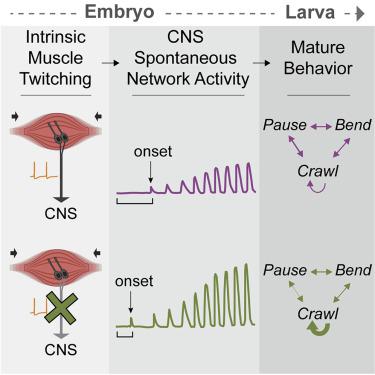Current Biology ( IF 9.2 ) Pub Date : 2021-09-02 , DOI: 10.1016/j.cub.2021.08.022 Arnaldo Carreira-Rosario 1 , Ryan A York 2 , Minseung Choi 2 , Chris Q Doe 3 , Thomas R Clandinin 2

|
Neural activity sculpts circuit wiring in many animals. In vertebrates, patterned spontaneous network activity (PaSNA) generates sensory maps and establishes local circuits.1, 2, 3 However, it remains unclear how PaSNA might shape neuronal circuits and behavior in invertebrates. Previous work in the developing Drosophila embryo discovered intrinsic muscle activity that did not require synaptic transmission, and hence was myogenic, preceding PaSNA.4, 5, 6 These studies, however, monitored muscle movement, not neural activity, and were therefore unable to observe how myogenic activity might relate to subsequent neural network engagement. Here we use calcium imaging to directly record neural activity and characterize the emergence of PaSNA. We demonstrate that the spatiotemporal properties of PaSNA are highly stereotyped across embryos, arguing for genetic programming. Neural activity begins well before it becomes patterned, emerging during the myogenic stage. Remarkably, inhibition of mechanosensory input, as well as inhibition of muscle contractions, results in premature and excessive PaSNA, demonstrating that muscle movement serves as a brake on this process. Finally, transient mechanosensory inhibition during PaSNA, followed by quantitative modeling of larval behavior, shows that mechanosensory modulation during development is required for proper larval foraging. This work provides a foundation for using the Drosophila embryo to study the role of PaSNA in circuit formation, provides mechanistic insight into how PaSNA is entrained by motor activity, and demonstrates that spontaneous network activity is essential for locomotor behavior. These studies argue that sensory feedback during the earliest stages of circuit formation can sculpt locomotor behaviors through innate motor learning.
中文翻译:

电路形成过程中的机械感觉输入通过模式化的自发网络活动塑造果蝇的运动行为
神经活动塑造了许多动物的电路布线。在脊椎动物中,模式化自发网络活动 (PaSNA) 生成感觉图并建立局部回路。1,2,3 然而,PaSNA 如何塑造无脊椎动物的神经元回路和行为仍不清楚。先前在发育中的果蝇胚胎中的工作发现了不需要突触传递的内在肌肉活动,因此是肌源性的,先于 PaSNA.4,5,6 然而,这些研究监测的是肌肉运动,而不是神经活动,因此无法观察到肌源性活动如何与随后的神经网络参与相关。在这里,我们使用钙成像直接记录神经活动并表征 PaSNA 的出现。我们证明 PaSNA 的时空特性在胚胎中是高度刻板的,这支持遗传编程。神经活动在形成模式之前就开始了,在生肌阶段出现。值得注意的是,机械感觉输入的抑制以及肌肉收缩的抑制会导致过早和过度的 PaSNA,这表明肌肉运动充当了这一过程的刹车。最后,PaSNA 期间的瞬时机械感觉抑制以及随后的幼虫行为定量建模表明,发育过程中的机械感觉调节对于幼虫的适当觅食是必需的。这项工作为利用果蝇胚胎研究 PaSNA 在回路形成中的作用奠定了基础,提供了 PaSNA 如何被运动活动夹带的机制见解,并证明自发网络活动对于运动行为至关重要。这些研究认为,回路形成的最早阶段的感觉反馈可以通过先天运动学习来塑造运动行为。



























 京公网安备 11010802027423号
京公网安备 11010802027423号